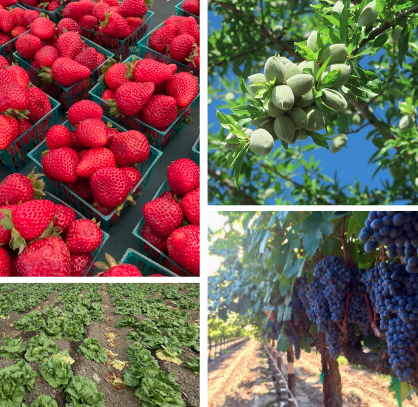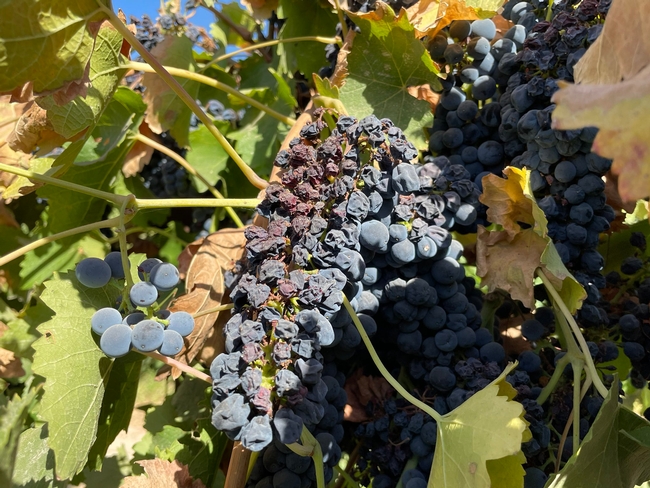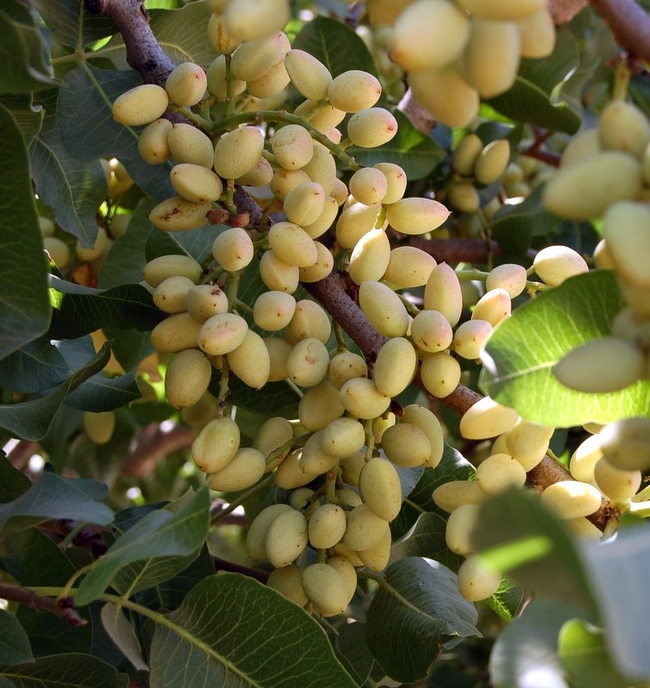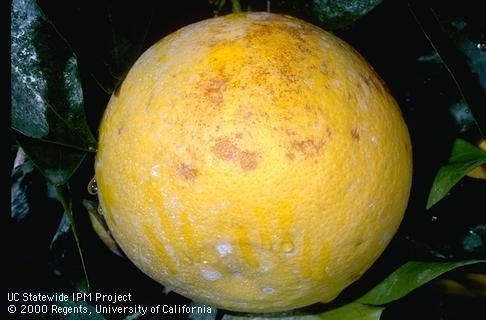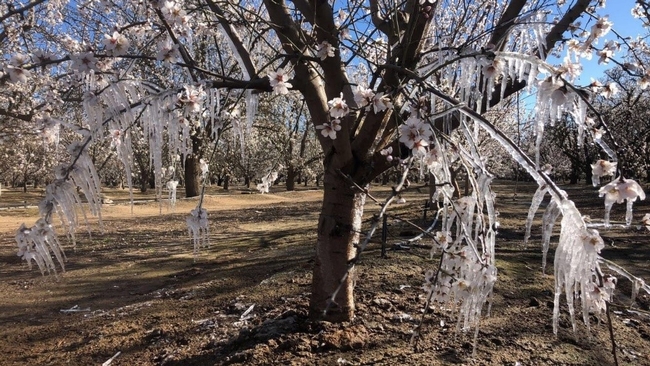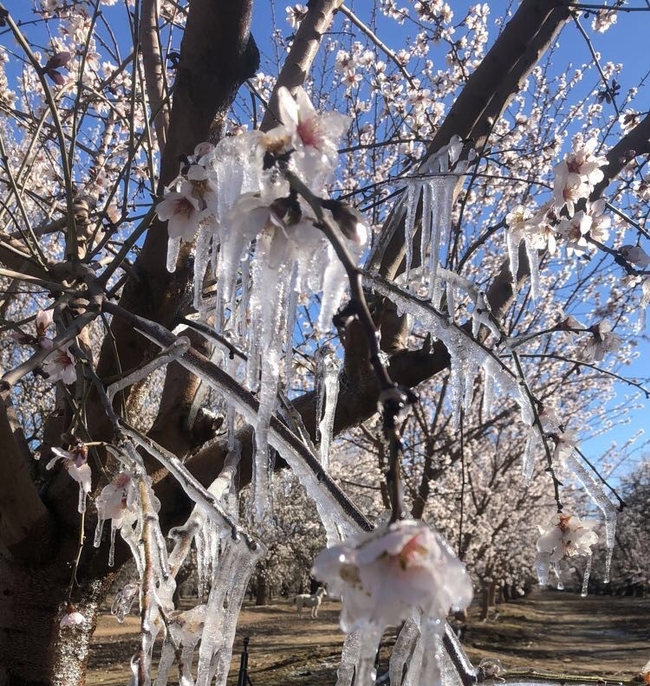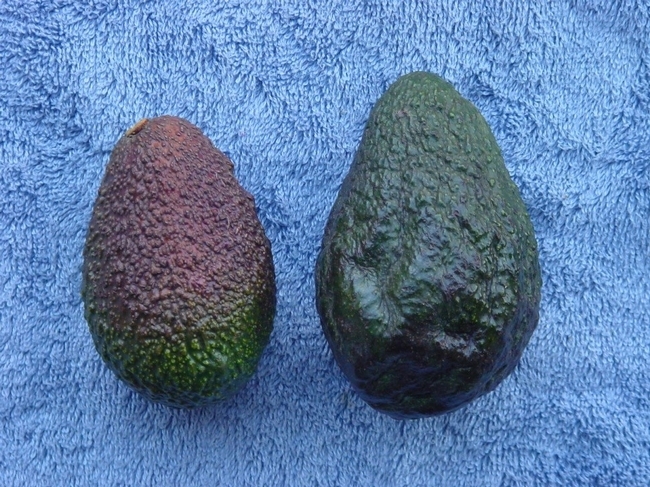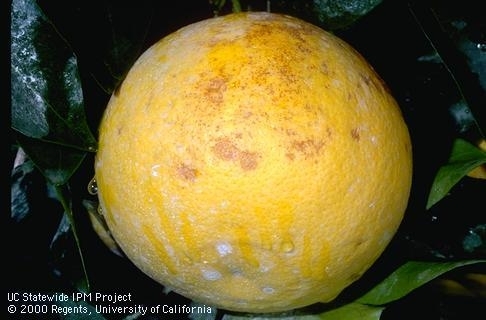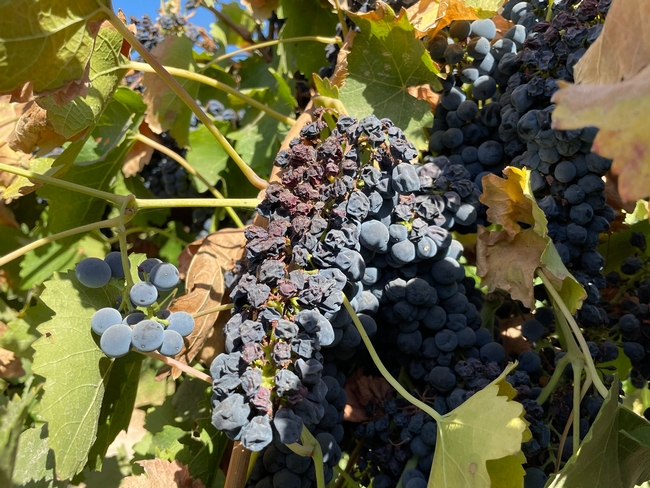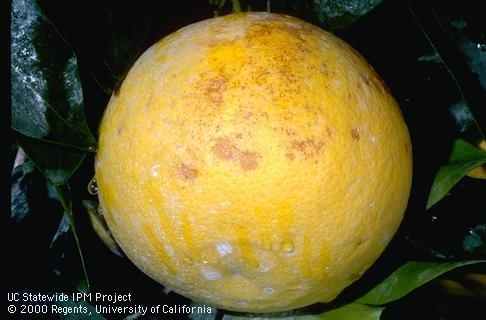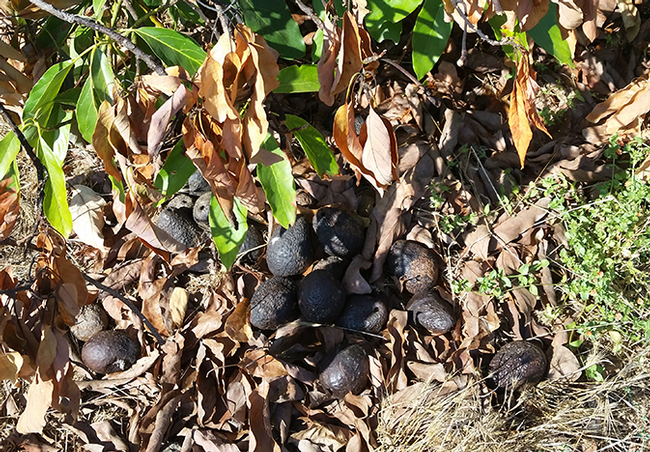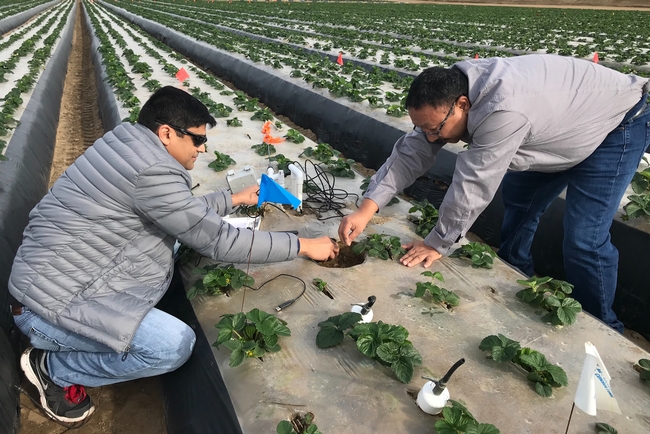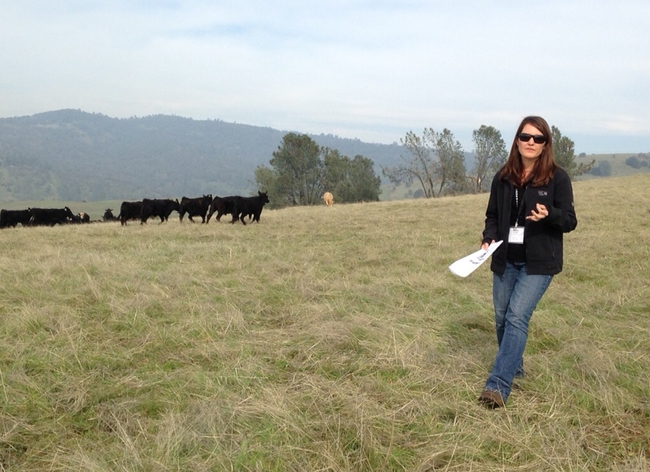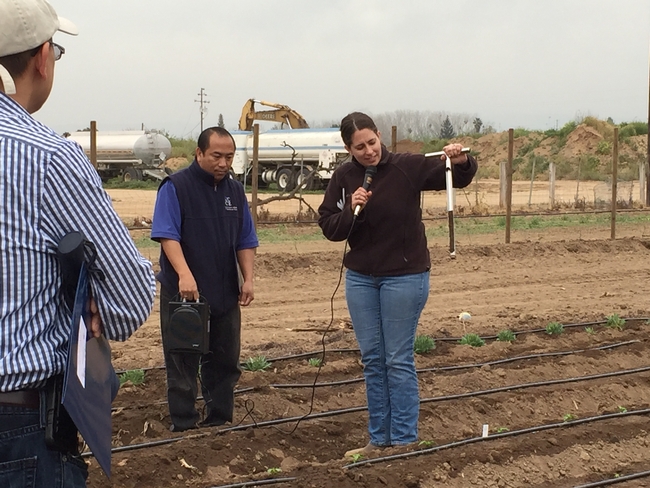Posts Tagged: Tapan Pathak
Climate-smart crop production workshops March 5-7 in Ventura, Salinas and Tulare
Growers invited to learn how to manage risks to fruit, nut, vegetable production
UC Cooperative Extension is offering workshops in Ventura, Salinas and Tulare to help growers adapt their fruit, nut and vegetable production practices to variable climate conditions.
"Growers, farm and ranch managers, and technical assistance providers can learn about the latest research and advances in managing risks to agricultural production that can result from climate change and climate variability,” said Daniele Zaccaria, associate professor in agricultural water management for Cooperative Extension at UC Davis.
Tapan Pathak, UCCE specialist at UC Merced, will speak about climate change trends, potential impacts on agricultural production and decision support tools. Zaccaria and local experts will discuss cover cropping, pests and other issues.
During a roundtable session, participants will discuss their own production challenges resulting from climate change and variability.
“Participants will also learn about tools available to aid manage climate change and climate variability risks," Zaccaria said.
The Climate-Smart Agricultural Production Practices workshops will be held in three locations:
Ventura: Vegetable and Berry Production
March 5 (8 a.m.–1:30 p.m.)
669 County Square Dr., Suite 100
Speakers include UCCE advisors Andre Biscaro, Ben Faber and Mark Battany, and other scientists and experts from Ventura County Resource Conservation District and Land IQ. Register at https://bit.ly/VenturaCrops.
Salinas: Vegetable, Berry and Grapevine Production
March 6 (8 a.m. –2 p.m.)
1432 Abbott St.
Speakers include Daniel Hasegawa and Eric Brennan of USDA-ARS and UCCE advisors Larry Bettiga, Michael Cahn and Mark Bolda. Register at https://bit.ly/SalinasCrops.
Tulare: Fruit and Nut Production
March 7 (8 a.m.–2 p.m.)
4500 South Laspina St.
Speakers include UCCE advisors Jhalendra Rijal, Mark Battany, Mohammad Yaghmour, Sandipa Gautam, Brent Holtz and other scientists and experts from USDA-NRCS, Almond Board of California; California Pistachio Research Board and Land IQ. Register at https://bit.ly/TulareCrops.
Workshops are free and include coffee breaks, lunch, workshop materials along with the presentations. Registration is required.
These workshops are supported by grants from the California Department of Food and Agriculture and USDA's National Institute of Food and Agriculture.
Key climate data added to enhance grower decision-support tool
Free CalAgroClimate tool helps growers protect crops from frost and extreme heat
California farmers can see how climatic conditions that may affect agriculture are changing in their regions by using CalAgroClimate so they can make strategic changes. Nine new agriculturally important climate indicatorshave been added to the decision-support tool created by UC Cooperative Extension and U.S. Department of Agriculture scientists.
These new tools use a high-resolution climate dataset called PRISM to provide location-specific or county-aggregated long-term trends in agroclimatic indicators from 1980 to last year. These new agroclimate indicators include Frost Days, Last Spring Freeze, First Fall Freeze, Freeze-Free Season, Tropical Nights, Hot Days, Extreme Heat Days, Heatwaves and Diurnal Temperature Range (see definitions below). These indicators were derived from a study published in the journal Agronomy.
All of the new tools are free and available on CalAgroClimate for anyone to access.
“Frost-related tools such as Frost Days, Last Spring Freeze, First Fall Freeze, and Freeze-Free Season can help farmers and agricultural clientele make informed long-term choices,” said Tapan B. Pathak, UC Cooperative Extension specialist in climate adaptation in agriculture based at UC Merced, who is leading the CalAgroClimate project.
“For instance, if you are planning to invest in a frost sensitive crop in your region, these indicators can provide valuable information on whether frost risk has changed over time and whether it is less risky to make such an investment,” he said. “Wine grapes, for instance, are very sensitive to frost. Although not all frost events are damaging, understanding long-term trends in frost can help in making long-term strategic decisions such as whether to invest in frost protections.”
Another set of new agroclimatic indicators, on CalAgroClimate – Tropical Nights, Hot Days, Extreme Heat Days, Heatwaves and Diurnal Temperature Range – are based on higher maximum and minimum temperatures. Tropical Nights, for instance, calculates total number of nights when overnight temperatures exceed 68 F. More frequent tropical nights can increase crop respiration rates and can be detrimental for fruit quality and quantity, increase the risk of damage from pathogens, and potentially impact fruit set and yield.
Knowing how trends are evolving over time can assist growers in managing their crops to reduce risks. Similarly, growers can easily look at trends related to heat – hot days, extreme heat and heatwaves – on CalAgroClimate to assess their options on what they need to do to be adaptive. In the short term, growers may put up shade or for longer term, choose varieties that are more heat-tolerant.
“In recently published work, one of the farmers in the Central Valley told us, ‘When you really see so much difference in a short amount of time in your immediate area…we would have to look at that and say, well, we're going to have to adapt varieties because this is a 20- or 25-year planting and we're going to have to find crops or varieties that will adapt to that,'” Pathak said.
Another farmer told us, “Knowing what's going to happen or at least having a good idea, if you know something's going to be become or won't be viable, then obviously you're going to try to phase that out, and phase in something that's better suited.”
Pathak added, “The new agroclimatic indicators on CalAgroClimate provide a reality check on how conditions are changing in short and long-term, what it means for farmers and to assist them on deciding what they need to do to be adaptive. These tools will greatly benefit farmers and agricultural clientele in assessing risks and making informed decisions.”
Other collaborators include StevenOstoja and Lauren Parker of theUSDA California Climate Hub,PrakashKumarJha of UC Agriculture and Natural Resources and Robert Johnson and ShaneFeirer of UC Agriculture and Natural Resources' Informatics and Geographic Information Systems.
Definitions of AgroClimatic Indicators:
Frost Days are days in a year with minimum temperature below or equal to 32F.
Last Spring Freeze is the latest day in spring when minimum temperature is below or equal to 32F.
First Fall Freeze is the earliest day in fall when minimum temperature falls to 32F or below.
Freeze-Free Season is the time between the last spring and first fall freeze, represented by the number of consecutive days in a year without freezing temperatures.
Tropical Nights are number of nights when temperatures exceed 68F.
Hot Days are the days per year with maximum temperature exceeding 100 °F.
Extreme Heat Days are the number of days per year with maximum temperatures warmer than the 98th percentile of historical summer maximum temperature for the selected location.
Heatwaves are events that occur when extreme heat lasts for at least three consecutive days.
Diurnal Temperature Range is the difference between daily maximum and minimum temperatures.
Climate change may reduce frost damage to orchard crops
CalAgroClimate web tools help farmers prepare for frost events
A cold snap damaged almond blossoms across the Central Valley, resulting in more than $44 million in crop insurance claimsin late February 2018. A multi-day frost event wiped out roughly 75% of California's citrus crop and severely damaged avocados in January 2007. Frost can damage crops, impact growers' bottom lines and drive up food prices for consumers. With advance notice, farmers may be able to use heaters, wind machines, irrigation and other tactics to lessen some of the impacts of cold weather, such as damaging near-ripe citrus fruit or killing the bloom in almonds.
CalAgroClimate is a new farmer-focused website that can help growers anticipate weather-related risks and make plans for taking defensive action. Growers and crop consultants can use CalAgroClimate's crop and location-specific tools and resources to help prepare for upcoming frost events. The website's tools can also support on-farm decisions for managing heat, crop development and pests.
Future holds less frost
The risk of frost damage to crops and the need to prepare for that risk is top-of-mind for many farmers today, but will it always be so? To examine what climate change might mean for future frost risk, researchers at UC Davis, UC ANR and the USDA California Climate Hub conducted a study examining the incidence of temperatures below multiple “frost thresholds” during the months of critical development phases for three frost-sensitive California crops: almonds, avocados and navel oranges.
The researchers found that even during the coldest winters and springs, the incidence of frost exposure declined under projected mid-21st century climate conditions by more than 50% for almonds and oranges, and by more than 75% for avocados. While farmers in 2050 will not find frost risk to completely be a worry of climates past, they will not have to contend with the same frost concerns that farmers face today.
Beyond the obvious benefits of reduced risk of crop damages, additional benefits of reduced frost exposure include lower water use and energy costs associated with mitigation actions. Irrigation is a primary means of protecting crops from frost temperatures, and with fewer hours below freezing that means fewer hours of running water and using pumps. The authors of the future frost exposure study showed that growers may collectively save tens of thousands of acre feet of water and enjoy millions of dollars in energy savings.
Few aspects of climate change are considered “positives,” and although the warming winters and springs that result in reduced frost temperatures could also come with increased pest pressure, reduced chill accumulation and other challenges, the reduction in frost exposure is a silver lining.
However, until this frost-free future arrives, growers still need to be prepared to protect their orchards from frost. To assess frost risk for the next seven days for your location, check out the new interactive Frost Advisory Tool at CalAgroClimate.org.
New interactive web tools help growers cope with climate change
UCCE, USDA California Climate Hub launch CalAgroClimate decision-support tool
Climate and weather variability pose increasing risks to farmers. As world leaders gather in Egypt at COP27 to address the climate crisis, University of California Cooperative Extension and the USDA California Climate Hub are launching new web-based tools to provide farmers with locally relevant and crop-specific information to make production decisions that reduce risk.
“Integrating historical weather data and forecast information with meaningful agricultural decision support information holds the potential to reduce a crop's vulnerability to such risks,” said Tapan Pathak, UC Cooperative Extension climate adaptation specialist at UC Merced.
“To provide easy access to high-resolution data in the form of agroclimate tools and information, and to enhance agricultural resilience to climate and weather-related risks, we are launching CalAgroClimate,” Pathak said.
Pathak is collaborating on building the decision support tool with partners from the U.S. Department of Agriculture, California Climate Hub, UC Cooperative Extension and UC Agriculture and Natural Resources' Informatics and Geographic Information Systems or IGIS.
“CalAgroClimate has been designed to support climate-enabled decision making for those working in the California specialty crop industry,” said Steven Ostoja, Director USDA California Climate Hub. “The USDA California Climate Hub is a proud collaborator on this important initiative to ensure the state's agricultural industry can continue to thrive in a future of climate change.”
Shane Feirer and Robert Johnson of UC ANR IGIS designed the interactive tools on the website and Lauren Parker of the USDA California Climate Hub contributed to content organization.An advisory panel composed of colleagues from UCCE and the Natural Resources Conservation Service ensure CalAgroClimate tools are relevant to stakeholder needs.
“CalAgroClimate is an amazing new tool that puts comprehensive past and forecast weather data at any grower's disposal,” said Mark Battany, UC Cooperative Extension water management and biometeorology advisor for San Luis Obispo and Santa Barbara counties.
“California's high-value crops are subject to a myriad of weather-related risk factors; this tool will allow growers to better address both near-term and long-term risks, and in the end grow more profitably, said Battany, who is a member of the CalAgroClimate advisory panel.
Growers and crop consultants can use CalAgroClimate's crop and location-specific tools and resources to help make on-farm decisions, such as preparing for frost or untimely rain and taking advantage of expected favorable conditions.
CalAgroClimate currently includes heat advisory, frost advisory, crop phenology and pest advisory tools.
Heat advisory tool: Extreme heat poses a danger for people, animals and crops. With this tool, users can select location and temperature threshold (e.g. 90 F, 95 F 100 F) based on their crop-specific heat tolerance level and the tool will provide a customized map of heat risk for next seven days for that location, including the number of consecutive days with temperature above that threshold. Users can also assess overall heat risks across the state for a selected temperature threshold as well. Having an early warning about hot temperatures, growers can take steps to reduce risks associated with extreme heat such as providing shade, changing farm workers' schedules and applying additional irrigation.
Frost advisory tool: Frost risk is a very serious issue for many specialty crops across California. Similar to the heat advisory tool, this tool provides a customized map of frost advisory for next seven days for a user's location, and forecast of consecutive days with temperature falling below the selected temperature thresholds (e.g. 35 F, 32 F, 28 F). Similar to the heat advisory, early warning about cold temperatures can provide growers some time to protect their crops from frost damage.
Crop phenology tool: The scientists have developed a-crop specific and location-specific crop phenology tool to help users keep track of growing degree days accumulations and estimate critical growth stages. CalAgroClimate uses a high-resolution PRISM dataset to provide near real-time crop phenology information to users. This tool will inform growers about how their crop development compares to previous years, which can be helpful in planning activities specific to critical growth stages.
Pest advisory tool: Similar to crops, development of certain pests and diseases is controlled by temperature and heat unit accumulations. With the pest advisory tool, growers can keep track of estimated pest generations during the growing season to make pest management decisions.
“We are launching the website with this initial set of tools while working on adding more crop-specific information and several new tools in the near future, ” Pathak said. “We look forward to getting feedback from growers who use CalAgroClimate to make it even more useful.”
UC ANR scientists receive $1.5M NIFA grant for climate-smart agriculture
To help California farmers and ranchers adjust to uncertain weather and climate events, the USDA National Institute for Food and Agriculture has awarded $1.5 million to a team of scientists led by UC Agriculture and Natural Resources. The project is one of six projects funded by USDA NIFA's $9 million investment to expand adoption of climate-smart practices.
“The Cooperative Extension system and the USDA Climate Hubs have unmatched capacity to reach agricultural, Tribal and underserved communities, as well as educators and students, and our nation's farmers directly,” said Agriculture Secretary Tom Vilsack in a statement announcing the grant recipients. “This partnership will strengthen climate research efforts and accelerate the development, adoption and application of science-based, climate-smart practices that benefit everyone.”
California has the largest and the most diverse agricultural economy in the nation, with revenue exceeding $50 billion, which is larger than the revenues of the other 10 Western states combined. Despite its size, the state is highly vulnerable to climate change.
“California farmers and ranchers need locally relevant climate information and adaptation resources,” said Tapan Pathak, UC Cooperative Extension specialist based at UC Merced and principal investigator for the grant. “Similarly, technical service providers are often ill-equipped to assist farmers and ranchers when asked questions about climate change, weather variability and local implications to implement those decisions.”
To train the next generation of workers to be climate-ready, colleges expose students to climate science and agricultural science separately, but often lack opportunities for the students to learn about the nexus of climate and agriculture.
Pathak plans to provide classes – along with opportunities for practical learning experiences – to farmers, ranchers, agricultural service providers and students.
“An overarching goal of this project is to develop robust multifaceted pathways to climate-smart agriculture by integrating Extension and participatory education program development and delivery to enhance agricultural resilience to climate change,” he said.
“To tackle this ambitious goal, we have a large team of multidisciplinary leading scientists and experts from local, state and federal agencies, the California Climate Hub and the University of California ready to work with diverse stakeholder groups.”
UC Cooperative Extension specialists Leslie Roche, Vikram Koundinya and Daniele Zaccaria at UC Davis; Mark Cooper, UC Davis professor; and Steven Ostoja of the USDA California Climate Hub, are co-principal investigators with Pathak.
They will begin with a needs assessment for all of their stakeholders, including socially disadvantaged farmers and ranchers. Through three components, the project team will work to understand growers' perception of climate change-related threats, build capacity for technical assistance providers to advance climate-smart agriculture research and delivery of science-based information, and educate community college and undergraduate university students.
Engaging with farmers and ranchers
With the help of community partners including the Community Alliance of Family Farmers and the California Association of Resource Conservation Districts, the team will reach out to socially disadvantaged and limited-resource producers, including beginning and first-generation farmers and ranchers to attend regional workshops, led by instructors who are fluent in Spanish and Hmong.
Workshop content will address a broad range of topics including climate change trends and local impacts, drought planning strategies, optimization of agricultural productivity with limited resources and farm and ranch economic sustainability.
“California has so much diversity in terms of scale, crops, geography, micro-climates, market conditions and natural resource considerations that a one-size-fits-all approach will not work,” wrote Renata Brillinger, CalCAN executive director, in her letter supporting the project. “We support your plans to address the needs of producers though region-specific workshops.”
Five county-based UC Cooperative Extension academics will serve as regional leads for the farming workshops across broad geographic regions:
- Andre Biscaro, UCCE irrigation and water resources advisor serving Ventura County
- Ruth Dahlquist-Willard, UCCE small farms advisor for Fresno and Tulare counties
- Surendra Dara, UCCE entomology and biologicals advisor serving San Luis Obispo and Ventura counties
- Jairo Diaz, director of the UC Desert Research and Extension Center in Southern California
- Jhalendra Rijal, UCCE integrated pest management advisor serving San Joaquin and Merced counties
Workshops for ranchers and rangeland managers will be coordinated by UCCE rangeland and livestock advisors in their respective regions:
- Dan Macon, UCCE livestock and natural resources advisor for Plumas, Nevada, Sutter and Yuba counties, will organize workshops for the Sierra Nevada mountains and foothill region
- Grace Woodmansee, UCCE livestock and natural resources advisor for Siskiyou County, will organize workshops in Northern California
- Rebecca Ozeran, UCCE livestock and natural resources advisor for Fresno and Madera counties, will organize workshops in Central California
- Devii Rao, UCCE livestock and natural resources advisor for Monterey, San Benito and Santa Cruz counties, will organize workshops in the coastal region
- Brooke Latack, UCCE livestock advisor for Imperial, Riverside and San Bernardino counties, will organize workshops in Southern California
Training technical service providers
The team will offer climate-smart agriculture trainings for technical service providers on how to prepare for key stressors in California agriculture such as floods, droughts, wildfires and heatwaves; effective climate communications; invasive pests and disease management under future climate; and weather and climate resources and decision support tools for managing risks.
One of the aims of this component is to encourage more coordinated efforts among different agencies to deliver climate change resources to their respective stakeholders, Pathak said.
California Cattlemen's Association has expressed its support for the project.
“Given ranchers' strong relationships with and reliance upon technical services providers – particularly those housed within the USDA and University of California – CCA also sees great value in the project's goal of building capacity within those organizations to assist ranchers in addressing the challenges of climate change,” wrote Kirk Wilbur, CCA vice president of government affairs.
Nurturing future generations
For college students, there will be the UC Merced Summer Institute on Climate and Agriculture certificate course organized by Karina Diaz Rios, UC Cooperative Extension specialist based at UC Merced; the UC Davis credit-based course “Science and Society: Climate Change and Agriculture;”and a certificate course for community college students, which will be overseen by the Bay Area Community College Consortium of 28 colleges.
“We will join you in this exciting work and shared vision towards inclusive education in climate resilient agriculture,” wrote Nancy Gutierrez, statewide director of the Agriculture, Water, Environmental Tech sector of the California Community College System.
Students from the three courses will be selected for paid summer internships to engage in Cooperative Extension projects.
“Through climate-smart agriculture education, the workforce will be prepared to advance climate science and research efforts for future generations,” Pathak said.

